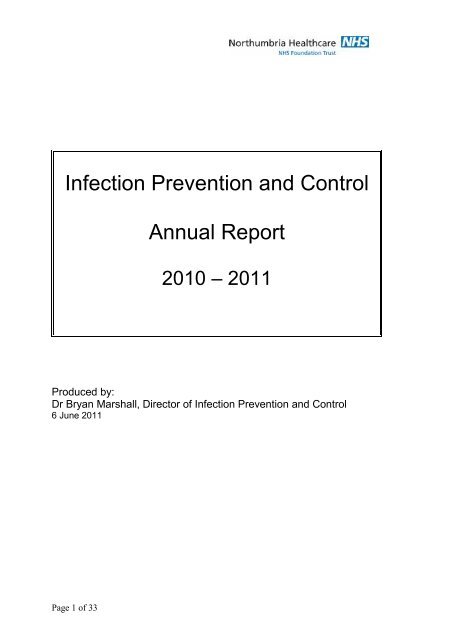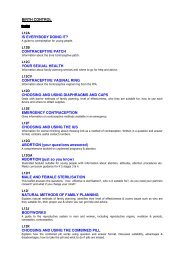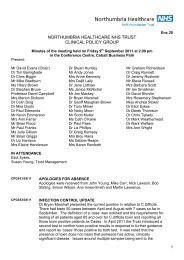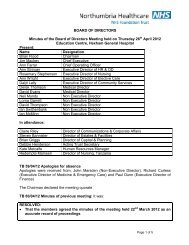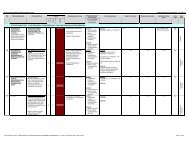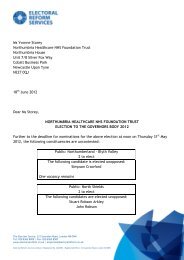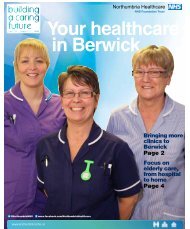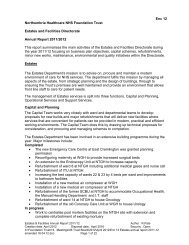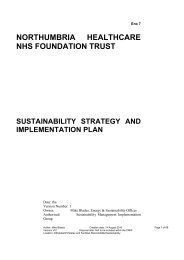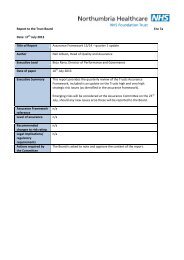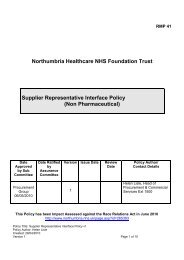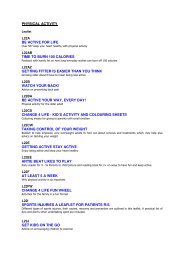Infection Prevention and Control Annual Report - Northumbria NHS ...
Infection Prevention and Control Annual Report - Northumbria NHS ...
Infection Prevention and Control Annual Report - Northumbria NHS ...
You also want an ePaper? Increase the reach of your titles
YUMPU automatically turns print PDFs into web optimized ePapers that Google loves.
<strong>Infection</strong> <strong>Prevention</strong> <strong>and</strong> <strong>Control</strong><br />
<strong>Annual</strong> <strong>Report</strong><br />
2010 – 2011<br />
Produced by:<br />
Dr Bryan Marshall, Director of <strong>Infection</strong> <strong>Prevention</strong> <strong>and</strong> <strong>Control</strong><br />
6 June 2011<br />
Page 1 of 33
Contents<br />
Page<br />
Executive summary 3<br />
1. Introduction 4<br />
2. <strong>Infection</strong> <strong>Control</strong> Arrangements<br />
- Trust Board<br />
- <strong>Infection</strong> <strong>Control</strong> Team<br />
- <strong>Infection</strong> <strong>Control</strong> Committee<br />
- Assurance Framework<br />
3. Health <strong>and</strong> Social Care Act 2008 – Code of Practice for the <strong>Prevention</strong> 5<br />
<strong>and</strong> <strong>Control</strong> of Healthcare Associated <strong>Infection</strong><br />
4. <strong>NHS</strong>LA st<strong>and</strong>ards 5<br />
5. <strong>Annual</strong> programme 2010-11 6<br />
6. <strong>Annual</strong> programme 2011-12 7<br />
7. Service Improvement – MRSA improvement programme 7<br />
8. Service Improvement – Clostridium difficile improvement programme 8<br />
9. Service improvement – surgical site infection improvement programme 8<br />
10. Outbreaks 9<br />
11. Other surveillance programmes 9<br />
12. Audit 10<br />
13. Education <strong>and</strong> Training 11<br />
14. Decontamination <strong>and</strong> cleanliness 12<br />
15. Antibiotic stewardship 12<br />
16. Patient <strong>and</strong> public involvement 12<br />
17. North of Tyne HCAI group 12<br />
18. Safer Care NE 12<br />
19. The future 13<br />
Appendix 1: Health <strong>and</strong> Social Care Act 2008 self assessment compliance 14<br />
summary March 2011<br />
Appendix 2: Health <strong>and</strong> Social Care Act 2008 outcome data March 2011 21<br />
Appendix 3: <strong>Annual</strong> programme 2010-11 – progress report 27<br />
Appendix 4: <strong>Annual</strong> programme for Acute services 2011-12 30<br />
List of tables <strong>and</strong> charts<br />
Figure Description Page<br />
1 MRSA bacteraemias identified by <strong>Northumbria</strong> Healthcare <strong>NHS</strong> Foundation 7<br />
Trust compared to target, for period April 2002 to March 2011.<br />
2 Timing of specimen collection in relation to admission for MRSA bacteraemias 7<br />
3 Number of newly diagnosed cases of C.difficile infection developing in<br />
8<br />
hospitalised patients in <strong>Northumbria</strong> Healthcare <strong>NHS</strong> Foundation Trust in 2008-<br />
10 against target trajectory<br />
4 Wards with outbreaks of diarrhoea <strong>and</strong> vomiting consistent with norovirus 9<br />
infection<br />
5 MSSA bacteraemias identified by <strong>Northumbria</strong> Healthcare <strong>NHS</strong> Foundation 10<br />
Trust in 2010-11, split into pre- <strong>and</strong> post- 48 hour samples<br />
6 Aggregated monthly compliance data for h<strong>and</strong> hygiene, IV device care plan use, 10<br />
<strong>and</strong> commode cleanliness for April 2010-March 2011<br />
7 <strong>Infection</strong> control audit compliance 11<br />
4<br />
4<br />
4<br />
4<br />
5<br />
Page 2 of 33
Executive summary<br />
Healthcare associated infection (HCAI) continues to be a priority for the <strong>NHS</strong>. The<br />
number of meticillin resistant Staphylococcus aureus (MRSA) bacteraemias <strong>and</strong><br />
Clostridium difficile cases occurring in a Trust are used as performance indicators <strong>and</strong><br />
there are targets to reduce the number of cases.<br />
Within <strong>Northumbria</strong> Healthcare <strong>NHS</strong> Foundation Trust, infection prevention <strong>and</strong><br />
control is seen as a high priority, with engagement <strong>and</strong> ownership at all levels from<br />
board to ward. Improvement programmes to reduce the number of MRSA<br />
bacteraemias <strong>and</strong> C.difficile cases continue to be implemented. These have resulted<br />
in a 33% reduction in the number of cases of MRSA bacteraemia developing 48 hours<br />
or more after admission, in 2010-11 compared to 2009-10. The number of cases of<br />
C.difficile in those aged 2 years <strong>and</strong> over, where the infection has developed in<br />
hospital has been reduced by 25% during 2010-11 compared to 2009-10.<br />
Following a self-assessment, the Trust declared itself compliant with the Health <strong>and</strong><br />
Social Care Act 2008 Code of Practice for the <strong>Prevention</strong> <strong>and</strong> <strong>Control</strong> of Healthcare<br />
Associated <strong>Infection</strong>s (the Hygiene code) by having appropriate systems in place to<br />
protect patients, staff <strong>and</strong> the public from healthcare associated infection.<br />
Page 3 of 33
1. Introduction<br />
This is the <strong>Infection</strong> <strong>Prevention</strong> <strong>and</strong> <strong>Control</strong> <strong>Annual</strong> <strong>Report</strong> for <strong>Northumbria</strong> Healthcare<br />
<strong>NHS</strong> Foundation Trust, produced by Dr Bryan Marshall, Director of <strong>Infection</strong><br />
<strong>Prevention</strong> <strong>and</strong> <strong>Control</strong> (DIPC) as required by the Health <strong>and</strong> Social Care Act 2008<br />
Code of Practice for the <strong>Prevention</strong> <strong>and</strong> <strong>Control</strong> of Healthcare Associated <strong>Infection</strong><br />
(Hygiene Code).<br />
The report details the structures <strong>and</strong> systems in place, <strong>and</strong> actions taken, to protect<br />
patients, staff <strong>and</strong> the public from healthcare associated infection. It covers the period<br />
April 2010 to March 2011.<br />
2. <strong>Infection</strong> <strong>Prevention</strong> <strong>and</strong> <strong>Control</strong> Structures<br />
Trust Board<br />
The delivery of excellence in safety <strong>and</strong> quality is a high priority for <strong>Northumbria</strong><br />
Healthcare <strong>NHS</strong> Foundation Trust. The Trust Board of <strong>Northumbria</strong> Healthcare <strong>NHS</strong><br />
Foundation Trust has the collective responsibility for ensuring that the risks of infection<br />
in the organisation are minimised <strong>and</strong> that the general means by which it prevents <strong>and</strong><br />
controls such risks are in place. The Board provides strategic leadership to ensure the<br />
effective delivery <strong>and</strong> management of patient safety in relation to infection prevention<br />
<strong>and</strong> control. <strong>Infection</strong> prevention <strong>and</strong> control is embedded into strategic planning <strong>and</strong><br />
thus into service delivery across the Trust. The Director of <strong>Infection</strong> <strong>Prevention</strong> <strong>and</strong><br />
<strong>Control</strong> (DIPC) is directly accountable to the Chief Executive <strong>and</strong> Trust Board, <strong>and</strong><br />
provides regular reports to the Board on compliance with infection control st<strong>and</strong>ards,<br />
<strong>and</strong> on progress in delivering reductions in MRSA bacteraemias <strong>and</strong> Clostridium<br />
difficile infections.<br />
<strong>Infection</strong> <strong>Prevention</strong> <strong>and</strong> <strong>Control</strong> Team<br />
The <strong>Infection</strong> <strong>Control</strong> service is part of the Clinical Support <strong>and</strong> Cancer Services<br />
Business Unit.<br />
The <strong>Infection</strong> <strong>Prevention</strong> <strong>and</strong> <strong>Control</strong> Team is led by Dr Bryan Marshall, Director of<br />
<strong>Infection</strong> <strong>Prevention</strong> <strong>and</strong> <strong>Control</strong>.<br />
<strong>Infection</strong> <strong>Control</strong> Committee<br />
The <strong>Infection</strong> <strong>Control</strong> Committee is responsible for the strategic planning of infection<br />
prevention <strong>and</strong> control across <strong>Northumbria</strong> Healthcare <strong>NHS</strong> Foundation Trust, with full<br />
consultation with all stakeholders. Membership of this committee includes broad<br />
representation from Directorate Clinical Governance Leads, Modern Matrons, Estates,<br />
Pharmacy, Occupational Health <strong>and</strong> the <strong>Infection</strong> <strong>Control</strong> team. The committee acts<br />
as a source of expert advice to the Executive on <strong>Infection</strong> <strong>Prevention</strong> <strong>and</strong> <strong>Control</strong><br />
issues. It reviews information on rates of healthcare associated infections <strong>and</strong> ensures<br />
appropriate policies <strong>and</strong> procedures are in place to minimise the risk. It endorses <strong>and</strong><br />
monitors the <strong>Infection</strong> <strong>Control</strong> <strong>Annual</strong> Programme, <strong>and</strong> the work of the MRSA<br />
improvement programme <strong>and</strong> Clostridium difficile improvement programme.<br />
The implementation of infection prevention <strong>and</strong> control improvement programmes is<br />
delivered through modern matrons <strong>and</strong> clinical teams with guidance <strong>and</strong> support from<br />
Page 4 of 33
the infection prevention <strong>and</strong> control team <strong>and</strong> infection control committee. Weekly<br />
meetings are teleconferenced across the Trust <strong>and</strong> attended by modern matrons,<br />
managers <strong>and</strong> the infection control team to review audit data, root cause analyses of<br />
cases of HCAI <strong>and</strong> ensure the on-going implementation of high st<strong>and</strong>ards of infection<br />
prevention <strong>and</strong> control.<br />
Assurance Framework<br />
The Trust’s Assurance Framework includes the risks, controls <strong>and</strong> related assurances<br />
that underpin the delivery of the principal objectives <strong>and</strong> is monitored <strong>and</strong> updated by<br />
the Assurance Committee on a quarterly basis reporting to the Trust Board. Risks<br />
associated with <strong>Infection</strong> <strong>Control</strong> that may affect the Trust achieving its corporate<br />
objectives appear on the Assurance Framework.<br />
The <strong>Infection</strong> <strong>Control</strong> risk register (which is part of the Clinical Support <strong>and</strong> Cancer<br />
Services Business Unit risk register), is reported to the <strong>Infection</strong> <strong>Control</strong> Committee<br />
<strong>and</strong> also to the Clinical Support Operational Board with high risks reported to the<br />
Assurance Committee on a quarterly basis as part of the Trust wide risk register.<br />
The Director of <strong>Infection</strong> <strong>Prevention</strong> <strong>and</strong> <strong>Control</strong> is a core member of the Assurance<br />
Committee, reports directly to the Chief Executive <strong>and</strong> regularly to the Board on<br />
infection prevention <strong>and</strong> control performance.<br />
The Director of <strong>Infection</strong> <strong>Prevention</strong> <strong>and</strong> <strong>Control</strong> is also a member of the Safety <strong>and</strong><br />
Quality Committee, <strong>and</strong> provided presentations to the committee on a quarterly basis.<br />
The minutes of the <strong>Infection</strong> <strong>Control</strong> Committee are presented to the Safety <strong>and</strong><br />
Quality Committee.<br />
All <strong>Infection</strong> <strong>Control</strong> policies are ratified by the Assurance Policy Group, after approval<br />
by the <strong>Infection</strong> <strong>Control</strong> Committee.<br />
The Trust is required to comply with various national st<strong>and</strong>ards regarding infection<br />
control. These include the Health <strong>and</strong> Social Care Act 2008, <strong>and</strong> <strong>NHS</strong>LA risk<br />
management st<strong>and</strong>ard. The Trust is registered with the Care Quality Commission with<br />
regard to healthcare associated infection.<br />
3. Health <strong>and</strong> Social Care Act 2008 (Hygiene code)<br />
The Health <strong>and</strong> Social Care Act 2008 Code of Practice for the <strong>Prevention</strong> <strong>and</strong> <strong>Control</strong><br />
of Healthcare Associated <strong>Infection</strong>s was updated in December 2009 to include 10<br />
compliance criteria, which Trusts were required to comply with. Based on self<br />
assessment of these compliance criteria, the Trust declared itself to be compliant with<br />
these st<strong>and</strong>ards. The Trust has had unconditional registration with the Care Quality<br />
Commission from 1 st April 2009, with regard to infection control.<br />
The DIPC collates evidence on a regular basis, to show continued compliance with the<br />
relevant st<strong>and</strong>ards. This evidence is reviewed by the <strong>Infection</strong> <strong>Control</strong> Committee <strong>and</strong><br />
by the Assurance Committee on a quarterly basis. This evidence is shown in<br />
appendices 1 <strong>and</strong> 2.<br />
4. <strong>NHS</strong>LA<br />
In December 2009, the Trust achieved <strong>NHS</strong>LA st<strong>and</strong>ard level 3, including full<br />
compliance for both st<strong>and</strong>ard 4.9 <strong>Infection</strong> <strong>Control</strong> <strong>and</strong> st<strong>and</strong>ard 2.8 H<strong>and</strong> Hygiene<br />
training. The Trust has not been reassessed against these st<strong>and</strong>ards during 2010-11.<br />
Page 5 of 33
5. <strong>Annual</strong> Programme 2010-11<br />
There were 18 objectives in the infection control annual programme for 2010-2011.<br />
These formed the focus for the work of the infection prevention <strong>and</strong> control team <strong>and</strong><br />
cover objectives such as the delivery of the MRSA <strong>and</strong> C.difficile improvement<br />
programmes, compliance with the Health <strong>and</strong> Social Care Act 2008, education,<br />
training <strong>and</strong> audit, ensuring compliance with national guidance <strong>and</strong> co-operation with<br />
outside agencies.<br />
Progress towards completion of these objectives was regularly monitored by the<br />
infection control team <strong>and</strong> the infection control committee throughout the year.<br />
Satisfactory progress was made towards completion of all the objectives. Many of the<br />
objectives are ongoing activities, such as audit <strong>and</strong> training, <strong>and</strong> these will continue to<br />
be delivered in future years. The programme <strong>and</strong> progress made is detailed in<br />
appendix 3.<br />
6. <strong>Annual</strong> Programme 2011-12<br />
The infection prevention <strong>and</strong> control annual programme for the acute services for<br />
2011-12 was approved by the <strong>Infection</strong> <strong>Control</strong> Committee in March 2011. A copy of<br />
the objectives is included as appendix 4.<br />
7. Service Improvement – MRSA improvement<br />
programme<br />
Since the Secretary of State for Health issued new targets for MRSA bloodstream<br />
infections in acute <strong>NHS</strong> Trusts in Engl<strong>and</strong> in November 2004, huge improvements<br />
have been made in reducing MRSA bacteraemias in Engl<strong>and</strong>.<br />
Figure 1 shows the data for <strong>Northumbria</strong> Healthcare <strong>NHS</strong> Foundation Trust for the last<br />
6 years. For the period April 2005 to March 2010, the target was based on all cases of<br />
MRSA bacteraemia, community <strong>and</strong> hospital acquired, identified by <strong>Northumbria</strong><br />
Healthcare <strong>NHS</strong> Foundation Trust. For 2010-11, the target only included hospital<br />
acquired cases, defined as those taken 48 hours or more after admission. The final<br />
total for 2010-11 was 4 hospital acquired cases, against a target of 7 cases.<br />
Page 6 of 33
Figure 1: MRSA bacteraemias identified by <strong>Northumbria</strong> Healthcare <strong>NHS</strong> Foundation Trust compared<br />
to target, for period April 2002 to March 2011.<br />
90<br />
MRSA bacteraemias - actual v target<br />
target actual (counted against target) post 48hrs<br />
80<br />
79<br />
70<br />
60<br />
50<br />
59<br />
54<br />
52 52<br />
40<br />
30<br />
20<br />
41<br />
37<br />
33<br />
27<br />
30<br />
21<br />
25<br />
10<br />
0<br />
12<br />
11<br />
6<br />
7<br />
4<br />
2005-06 2006-07 2007-08 2008-09 2009-10 2010-11<br />
The data for the last 6 years shows a steady <strong>and</strong> sustained reduction in the number of<br />
cases of hospital acquired MRSA bacteraemias. In the first year of the MRSA<br />
bacteraemia improvement programme, 75% of cases were classified as hospital<br />
acquired. In 2010-11, there were more community acquired MRSA bacteraemias<br />
identified than hospital acquired MRSA bacteraemias, as shown in figure 2.<br />
Figure 2: Timing of specimen collection in relation to admission for MRSA bacteraemias<br />
MRSA bacteraemias identified by <strong>Northumbria</strong> lab<br />
70<br />
60<br />
50<br />
40<br />
30<br />
20<br />
10<br />
0<br />
2005-06 2006-07 2007-08 2008-09 2009-10 2010-11<br />
MRSA Pre-48hrs<br />
MRSA Post-48hrs<br />
Page 7 of 33
The work of the MRSA improvement programme continues, with the action plan<br />
regularly reviewed <strong>and</strong> updated with issues identified through root cause analysis<br />
which is undertaken for all cases of MRSA bacteraemia.<br />
8. Service Improvement – Clostridium difficile<br />
improvement programme<br />
National m<strong>and</strong>atory surveillance of Clostridium difficile infection in those aged 65<br />
years <strong>and</strong> over commenced in January 2007. The target was changed from April 2008<br />
by splitting those cases developing in hospital from those developing in the community<br />
<strong>and</strong> extended to include all those aged 2 years <strong>and</strong> over. Hospital apportioned cases<br />
were defined as those where the faecal specimen was collected more than 2 days<br />
after admission. Figure 3 shows the performance against target since April 2008.<br />
Figure 3: Number of newly diagnosed cases of C.difficile infection developing in hospitalised patients in<br />
<strong>Northumbria</strong> Healthcare <strong>NHS</strong> Foundation Trust in 2008-10 against target trajectory<br />
Trust apportioned C.difficile cases - actual v target<br />
target<br />
actual<br />
300<br />
250<br />
200<br />
254<br />
232<br />
221<br />
150<br />
100<br />
129<br />
124<br />
103<br />
50<br />
0<br />
2008-09 2009-10 2010-11<br />
Appropriate management of cases continues to be delivered through the use of an<br />
integrated care plan for use by all staff groups involved in the care of a patient <strong>and</strong> a<br />
weekly multi-disciplinary team meeting which reviews the care of all patients with<br />
C.difficile infection in the Trust. Root cause analysis is undertaken for all hospital<br />
acquired cases of C.difficile. The action plan to further reduce the number of cases, is<br />
reviewed <strong>and</strong> revised on a regular basis. Plans for 2011-12 include measures to<br />
further improve environmental cleanliness.<br />
9. Service improvement - Surgical Site <strong>Infection</strong><br />
improvement programme<br />
The Trust undertakes surveillance of surgical site infections following prosthetic knee<br />
<strong>and</strong> hip replacement <strong>and</strong> hip hemiarthroplasty, as part of the national surveillance<br />
scheme. This data is published by the Health Protection Agency <strong>and</strong> is available on its<br />
website. A surgical site infection project group has developed <strong>and</strong> is delivering an<br />
improvement programme.<br />
Page 8 of 33
10. Outbreaks<br />
Norovirus was again prevalent during 2010-11. Numerous outbreaks of gastroenteritis<br />
caused by norovirus occurred throughout the year both in hospital <strong>and</strong> the community.<br />
The high incidence in the community, especially in nursing <strong>and</strong> residential homes<br />
resulted in many hospital outbreaks following the admission of patients from the<br />
community with diarrhoea <strong>and</strong> vomiting.<br />
The <strong>Infection</strong> <strong>Control</strong> Team worked with Trust management, bed management, ward<br />
staff, domestics <strong>and</strong> other support staff to ensure that these outbreaks were contained<br />
as quickly as possible. A list of wards affected is given in figure 4.<br />
Figure 4: Wards with outbreaks of diarrhoea <strong>and</strong> vomiting consistent with norovirus infection<br />
Month North<br />
Tyneside<br />
General<br />
Wansbeck<br />
General<br />
Hospital<br />
Community<br />
hospitals<br />
Hexham<br />
General<br />
Hospital<br />
No. of<br />
symptomatic<br />
patients<br />
No. of<br />
symptomatic<br />
staff members<br />
Hospital<br />
Apr-10 wards 6 & wards 2, 8 Berwick nil 48 3<br />
8<br />
& 17 Dewar ward<br />
May-10 ward 8 wards 2, 8 nil nil 32 1<br />
& 22<br />
Jun-10 nil ward 3 nil ward 4 33 4<br />
Jul-10 nil wards 2 & nil nil 18 2<br />
22<br />
Aug-10 nil nil nil nil 0 0<br />
Sep-10 nil nil nil nil 0 0<br />
Oct-10 nil nil nil nil 0 0<br />
Nov-10 nil nil nil nil 0 0<br />
Dec-10 nil nil nil nil 0 0<br />
Jan-11 nil nil nil nil 0 0<br />
Feb-11 wards 5,<br />
8, 9, 12 &<br />
24<br />
Mar-11 wards 2,<br />
12, 14 &<br />
18<br />
wards 2,<br />
6, 7 & 8<br />
wards 3, 5<br />
& 22<br />
Haltwhistle,<br />
Blyth wards<br />
2 & 3<br />
wards 2 &<br />
3<br />
206 61<br />
Blyth ward 1 nil 85 16<br />
Four outbreaks due to Clostridium difficile were detected, affecting 3 patients at North<br />
Tyneside General Hospital in June 2010, 3 patients at North Tyneside General<br />
Hospital in October 2010, 3 patients at Wansbeck General Hospital in October 2010<br />
<strong>and</strong> 5 patients at North Tyneside General Hospital in February 2011.<br />
The infection control team, working with colleagues from the Health Protection<br />
Agency, also identified <strong>and</strong> managed a cluster of cases of Listeria infection, <strong>and</strong> a<br />
cluster of cases of infection/colonisation with a strain of carbapenemase-producing<br />
Klebsiella pneumoniae.<br />
11. Other surveillance programmes<br />
In October 2010, the Department of Health announced that it was going to extend the<br />
m<strong>and</strong>atory surveillances to include meticillin sensitive Staphylococcus aureus (MSSA)<br />
bacteraemias <strong>and</strong> E.coli bacteraemias. The surveillance of MSSA bacteraemias<br />
Page 9 of 33
commenced in January 2011, with E.coli bacteraemia surveillance starting in June<br />
2011.<br />
The data for MSSA bacteraemias for <strong>Northumbria</strong> Healthcare <strong>NHS</strong> Foundation Trust<br />
for 2010-11 is shown in figure 5.<br />
Figure 5: MSSA bacteraemias identified by <strong>Northumbria</strong> Healthcare <strong>NHS</strong> Foundation Trust in 2010-11,<br />
split into pre- <strong>and</strong> post- 48 hour samples<br />
Apr- May- Jun- Jul- Aug- Sep- Oct- Nov- Dec- Jan- Feb- Mar- Total<br />
10 10 10 10 10 10 10 10 10 11 11 11<br />
Pre 2 3 2 5 3 2 3 3 2 3 3 4 35<br />
48Hrs<br />
Post<br />
48Hrs<br />
1 1 2 2 1 0 2 2 4 1 3 1 20<br />
total 3 4 4 7 4 2 5 5 6 4 6 5 55<br />
12. Audit<br />
Wards <strong>and</strong> departments undertake weekly audits of h<strong>and</strong> hygiene, commode<br />
cleanliness, <strong>and</strong> intravascular device care. The data is reviewed at the weekly<br />
healthcare associated infection meetings, <strong>and</strong> deficiencies addressed by the Modern<br />
Matron responsible for the area concerned. Spot checks by the infection control team<br />
validate the data submitted by the wards. The aggregate monthly data is shown in<br />
figure 6.<br />
Figure 6: Aggregated monthly compliance data for h<strong>and</strong> hygiene, IV device care plan use, <strong>and</strong><br />
commode cleanliness for April 2010-March 2011<br />
Trust Apr May Jun Jul Aug Sep Oct Nov Dec Jan Feb Mar<br />
st<strong>and</strong>ard<br />
H<strong>and</strong> hygiene >95% 98.1<br />
%<br />
97.3<br />
%<br />
97.3<br />
%<br />
97.1<br />
%<br />
97.8<br />
%<br />
97.1<br />
%<br />
97.8<br />
%<br />
98.0<br />
%<br />
97.4<br />
%<br />
97.1<br />
%<br />
96.9<br />
%<br />
97.4<br />
%<br />
IV device care plan >95% 96.8<br />
%<br />
98.2<br />
%<br />
99.1<br />
%<br />
98.6<br />
%<br />
99.3<br />
%<br />
98.9<br />
%<br />
98.7<br />
%<br />
99.1<br />
%<br />
98.8<br />
%<br />
98.2<br />
%<br />
98.8<br />
%<br />
99.7<br />
%<br />
Commode<br />
cleanliness<br />
≥98% 98.6<br />
%<br />
97.6<br />
%<br />
96.7<br />
%<br />
98.2<br />
%<br />
99.1<br />
%<br />
98.7<br />
%<br />
98.7<br />
%<br />
98.9<br />
%<br />
98.2<br />
%<br />
98.7<br />
%<br />
98.0<br />
%<br />
99.1<br />
%<br />
Trust-wide audits of compliance with the MRSA policy <strong>and</strong> the C.difficile policy <strong>and</strong> of<br />
the care of central venous catheters were undertaken. Overall there was good<br />
compliance with these policies.<br />
There is a regular rolling programme of audits for all wards <strong>and</strong> departments, using<br />
the <strong>Infection</strong> <strong>Control</strong> Nursing Association audit tools, which is coordinated by the<br />
infection control team. This tool kit sets a level of 85% as compliant with the audit<br />
st<strong>and</strong>ard. Action plans are implemented in those areas falling below st<strong>and</strong>ard.<br />
The aggregated Trust wide results for the period April to December 2010, with<br />
comparable data for preceding years, are shown in figure 7. In reviewing the audit<br />
programme <strong>and</strong> tools in December 2010, it was decided that the infection control<br />
nurses would focus on auditing those aspects related to clinical care, with the<br />
environmental aspects picked up by the domestic monitoring team.<br />
Page 10 of 33
Figure 7: <strong>Infection</strong> <strong>Control</strong> Audit Compliance<br />
IC audit compliance<br />
2006/07 2007/08 2008/09 2009/10 Apr-Dec 2010<br />
105%<br />
average compliance<br />
100%<br />
95%<br />
90%<br />
85%<br />
80%<br />
75%<br />
70%<br />
91%<br />
92%<br />
95%<br />
93%<br />
96%<br />
93%<br />
95%<br />
97%<br />
97%<br />
97%<br />
95%<br />
95%<br />
97%<br />
97%<br />
99%<br />
97%<br />
98%<br />
92%<br />
97%<br />
98%<br />
94%<br />
96%<br />
96%<br />
96%<br />
96%<br />
94%<br />
96%<br />
98%<br />
98%<br />
99%<br />
93%<br />
94%<br />
95%<br />
95%<br />
97%<br />
89%<br />
91%<br />
91%<br />
92%<br />
91%<br />
87%<br />
91%<br />
90%<br />
91%<br />
92%<br />
92%<br />
94%<br />
95%<br />
95%<br />
96%<br />
65%<br />
60%<br />
Departmental<br />
w aste<br />
H<strong>and</strong> hygiene<br />
H<strong>and</strong>ling <strong>and</strong><br />
disposal of<br />
linen<br />
Isolation<br />
precautions<br />
Patient<br />
equipment<br />
(general)<br />
Personal<br />
protective<br />
equipment<br />
Safe h<strong>and</strong>ling<br />
<strong>and</strong> disposal<br />
of sharps<br />
Ward<br />
environment<br />
Ward kitchen<br />
All ICNA audits<br />
13. Education <strong>and</strong> training<br />
<strong>Infection</strong> prevention <strong>and</strong> control advice <strong>and</strong> information continues to be given to all<br />
new staff on their first day at work prior to commencing clinical duties as part of the<br />
induction video. The infection control section includes st<strong>and</strong>ard precautions <strong>and</strong> h<strong>and</strong><br />
hygiene training. E-learning packages are used for all junior doctors.<br />
M<strong>and</strong>atory training sessions have continued <strong>and</strong> attendance is monitored on a<br />
monthly basis. All staff are required to undergo h<strong>and</strong> hygiene training every two years.<br />
Over 2800 staff received h<strong>and</strong> hygiene training between April 2010 <strong>and</strong> March 2011.<br />
<strong>Infection</strong> control responsibilities are included in all job description <strong>and</strong> is one of the<br />
elements considered at annual appraisal.<br />
An infection control road show visited all Trust sites, during September <strong>and</strong> October<br />
2010, to raise awareness of h<strong>and</strong> hygiene <strong>and</strong> norovirus infection amongst staff,<br />
patients <strong>and</strong> visitors.<br />
An infection control study day for domestic staff was held at Cobalt in September<br />
2010.<br />
The annual infection control study day for nursing <strong>and</strong> allied health professionals was<br />
planned to take place on 2 nd December 2010 in the education centre at Hexham<br />
General Hospital. Unfortunately the adverse weather conditions meant that the event<br />
had to be postponed, <strong>and</strong> was rescheduled for May 2011.<br />
Development opportunities for the members of the infection prevention <strong>and</strong> control<br />
team are agreed at annual appraisal.<br />
Page 11 of 33
14. Decontamination <strong>and</strong> cleanliness<br />
Environmental cleanliness is monitored through the National cleanliness scores <strong>and</strong><br />
PEAT scores. These are consistently high, with any exceptions reported to the weekly<br />
healthcare associated infection meeting. Domestic service arrangements will be<br />
reviewed during 2011-12 as part of the work to further reduce cases of Clostridium<br />
difficile infection.<br />
15. Antibiotic stewardship<br />
The use of antibiotics is one of the key drivers for the increase in antibiotic resistance.<br />
<strong>Control</strong> of antibiotic use is therefore an important part of the control measures to<br />
reduce infection caused by antibiotic resistant organisms. Ensuring the<br />
appropriateness of antibiotic prescribing is a key component in reducing healthcare<br />
associated infection. In line with National guidance to reduce the risk of C.difficile<br />
infection, the use of certain antibiotics, such as cephalosporins <strong>and</strong> fluoroquinolones is<br />
strictly controlled within the Trust.<br />
16. Patient <strong>and</strong> public involvement<br />
It is important that patients <strong>and</strong> the public are informed about <strong>and</strong> involved in infection<br />
prevention <strong>and</strong> control activities. Patient information leaflets continue to be reviewed<br />
<strong>and</strong> updated. Good h<strong>and</strong> hygiene compliance is a fundamental part of the delivery of<br />
safe healthcare <strong>and</strong> remains a Trust priority. Alcohol gel dispensers <strong>and</strong> prominent<br />
signage at the hospital entrances as well as departmental <strong>and</strong> ward entrances,<br />
promote h<strong>and</strong> hygiene to patients <strong>and</strong> visitors, as well as staff. Manned stalls at the<br />
hospital entrances during the infection control road shows raised awareness of h<strong>and</strong><br />
hygiene <strong>and</strong> norovirus amongst staff, patients <strong>and</strong> visitors. Trust Board reports, which<br />
include information on infection prevention <strong>and</strong> control are publicly available on the<br />
internet site.<br />
There is patient <strong>and</strong> public governor representation on the MRSA <strong>and</strong> C.difficile<br />
steering groups.<br />
17. North of Tyne Healthcare Associated <strong>Infection</strong> Group<br />
The North of Tyne Healthcare Associated <strong>Infection</strong> Group has representatives from all<br />
<strong>NHS</strong> healthcare providers North of Tyne. The DIPC <strong>and</strong> lead nurse for infection<br />
control represent <strong>Northumbria</strong> Healthcare on this group. The aim of the group is to<br />
support <strong>and</strong> facilitate cross organisational working covering the whole health<br />
economy, to achieve sustainable reductions of MRSA bacteraemias <strong>and</strong> Clostridium<br />
difficile.<br />
18. Safer Care North East<br />
Safer Care North East was a 3 year strategy, lead by the North East SHA to improve<br />
patient safety. Healthcare Associated <strong>Infection</strong> as one of the eight clinical themes for<br />
which a programme of interventions was defined. An HCAI taskforce was formed <strong>and</strong><br />
identified objectives, goals, initiatives <strong>and</strong> measures. Representatives from most <strong>NHS</strong><br />
organisations across the region were involved in the programme. The DIPC for<br />
<strong>Northumbria</strong> Healthcare <strong>NHS</strong> Foundation Trust acted as the clinical chair for this<br />
group.<br />
Page 12 of 33
19. The future<br />
<strong>Infection</strong> prevention <strong>and</strong> control will continue to be a key element of the patient safety<br />
agenda. The MRSA bacteraemia target <strong>and</strong> the C.difficile reduction target will<br />
continue to be major drivers for improvement in infection prevention <strong>and</strong> control.<br />
The introduction of surveillance systems for MSSA bacteraemias <strong>and</strong> E.coli<br />
bacteraemias during 2011 will provide further data <strong>and</strong> may identify further work that<br />
can be done to improve patient safety.<br />
External scrutiny of infection prevention <strong>and</strong> control will involve the Care Quality<br />
Commission through compliance with the Health <strong>and</strong> Social Care Act 2008 code of<br />
practice (Hygiene Code), <strong>and</strong> by delivery of MRSA bacteraemia <strong>and</strong> C.difficile<br />
reduction targets as set by North of Tyne Commissioners.<br />
Page 13 of 33
Appendix 1 Health <strong>and</strong> Social Care Act 2008 compliance self assessment<br />
Safeguarding <strong>and</strong> safety<br />
Outcome 8 (Regulation 12):<br />
Cleanliness <strong>and</strong> infection control<br />
Providers of services comply with the requirements of regulation 12, with regard to<br />
the Code of Practice for health <strong>and</strong> adult social care on the prevention <strong>and</strong> control<br />
of infections <strong>and</strong> related guidance.<br />
8A<br />
Provide evidence to demonstrate that you are<br />
complying with the Code of Practice for health <strong>and</strong><br />
adult social care on the prevention <strong>and</strong> control of<br />
infections <strong>and</strong> related guidance.<br />
Green<br />
x<br />
Yellow Amber Red<br />
Summary of evidence to support the outcomes described in 8A<br />
Criterion 1: Systems to manage <strong>and</strong> monitor the prevention <strong>and</strong> control of infection.<br />
Processes<br />
- The Trust Board has a collective responsibility to approve <strong>and</strong> self-certify the Trust's<br />
<strong>Annual</strong> Plan.<br />
- Policy IC01 <strong>Infection</strong> control operational policy describes the infection prevention <strong>and</strong><br />
control structures in the Trust <strong>and</strong> details the assurance framework.<br />
- The Trust has a Director of <strong>Infection</strong> <strong>Prevention</strong> <strong>and</strong> <strong>Control</strong> accountable directly to the<br />
Chief Executive.<br />
- An annual programme is produced.<br />
- An audit programme is in place.<br />
- Training <strong>and</strong> information is delivered to all staff.<br />
- There is an executive lead for decontamination.<br />
- The Risk Register details identified risks, <strong>and</strong> required actions to reduce or control the<br />
risk. The Risk Registers are regularly reviewed<br />
- Action plans are produced <strong>and</strong> their delivery monitored<br />
-The DIPC is accountable directly to the Chief Executive <strong>and</strong> the Board<br />
- The DIPC leads the infection control team <strong>and</strong> chairs the infection control committee<br />
- The DIPC overseas the development <strong>and</strong> implementation of infection control policies<br />
- The DIPC is a member of the Trust's Assurance Committee <strong>and</strong> Safety <strong>and</strong> Quality<br />
Committee<br />
- The DIPC produces an <strong>Annual</strong> <strong>Report</strong> which is available on the Trust's internet site. The<br />
report includes surveillance data, audit data <strong>and</strong> progress against annual programme of<br />
activity.<br />
Page 14 of 33
- The Trust Board receives regular updates from the DIPC <strong>and</strong> Modern Matrons<br />
- Surveillance data for healthcare associated infections is presented to the infection<br />
control committee every two months. <strong>Infection</strong> related serious untoward incidents are<br />
reviewed through the appropriate clinical governance processes<br />
- Root cause analysis is undertaken for every MRSA bacteraemia <strong>and</strong> C.difficile case.<br />
Lessons learnt are disseminated via the business units, <strong>and</strong> used to inform the MRSA <strong>and</strong><br />
C.diffcile action plans<br />
- The <strong>Infection</strong> <strong>Control</strong> Team is led by the DIPC, <strong>and</strong> includes specialist nurses, <strong>and</strong><br />
medical microbiologists, with administrative <strong>and</strong> analytical support. 24 hour cover is<br />
provided by consultant medical microbiologists.<br />
- Bed management operational guidance <strong>and</strong> the infection control isolation policy ensure<br />
that appropriate movement <strong>and</strong> placement of patients. Daily review of high risk patients is<br />
undertaken by the infection control team <strong>and</strong> clinical staff. PAS alert codes facilitates the<br />
identification of patients previously positive for MRSA <strong>and</strong>/or C.difficile. Admission<br />
screening for MRSA identifies patients admitted with MRSA. Transfer <strong>and</strong> Discharge<br />
policy <strong>and</strong> associated documentation ensures the appropriate transfer of information when<br />
patients move between healthcare facilities/providers.<br />
Outcome measures<br />
Incidence of MRSA bacteraemias (hospital acquired)<br />
Incidence of C.difficile cases (hospital acquired)<br />
Audits<br />
- Commode cleanliness<br />
- H<strong>and</strong> hygiene<br />
- IV cannulation compliance (care plan)<br />
- Antibiotic prescribing compliance<br />
- Mattress integrity<br />
- MRSA policy compliance<br />
- C.difficile policy compliance<br />
- ICN environmental audits<br />
- departmental waste<br />
- h<strong>and</strong> hygiene<br />
- h<strong>and</strong>ling <strong>and</strong> disposal of linen<br />
- isolation precautions<br />
- patient equipment (general)<br />
- personal protective equipment<br />
- safe h<strong>and</strong>ling <strong>and</strong> disposal of sharps<br />
- ward environment<br />
- ward kitchen<br />
CQC inspection reports<br />
<strong>NHS</strong> LA st<strong>and</strong>ards (criterion 4.9)<br />
Orthopaedic surgical site infection surveillance<br />
Criterion 2: Provide <strong>and</strong> maintain a clean <strong>and</strong> appropriate environment in managed<br />
premises that facilitates the prevention <strong>and</strong> control of infections.<br />
Processes<br />
- there are designated leads for decontamination <strong>and</strong> for cleaning<br />
- lead for cleaning liaises closely with Director of Nursing, Modern Matrons <strong>and</strong> ICT in all<br />
aspects of service planning <strong>and</strong> delivery<br />
- Modern Matrons are responsible <strong>and</strong> accountable for ensuring a safe <strong>and</strong> clean care<br />
environment<br />
- Action plans are formulated to address any issues identified through PEAT inspections<br />
Page 15 of 33
- Regular monitoring of cleanliness, using National Cleanliness scores, is undertaken <strong>and</strong><br />
results reported back through business units <strong>and</strong> to Trust Board<br />
- Cleaning schedules displayed in all clinical areas<br />
- There are adequate h<strong>and</strong> hygiene facilities in clinical areas, including point of care<br />
alcohol h<strong>and</strong> rub<br />
- There are procedures in place for the cleaning of commodes <strong>and</strong> mattresses, backed up<br />
by audit processes<br />
- There are contracts in place for the supply <strong>and</strong> provision of linen <strong>and</strong> laundry<br />
- Policies <strong>and</strong> procedures are in place to ensure appropriate levels of cleanliness, building<br />
<strong>and</strong> refurbishment work is undertaken to an appropriate st<strong>and</strong>ard, for waste management,<br />
pest control, minimise risk of legionella, for food services <strong>and</strong> for planned preventative<br />
maintenance<br />
- The Trust has a cleaning strategy, which incorporates National Cleaning St<strong>and</strong>ards, <strong>and</strong><br />
the operational cleaning plan identifies specific roles<br />
- Cleaning schedules are publicly displayed<br />
- Procedures are in place to enable staff to request additional cleaning when required<br />
- There is a Cleaning <strong>and</strong> Disinfection policy, which details the different cleaning <strong>and</strong><br />
disinfection requirements of equipment<br />
- Most of the decontamination of re-usable medical devices is undertaken in centralised<br />
facilities (CSSD), with some local reprocessing (endoscopes)<br />
- Traceability system in place<br />
- Part of competency assessment in medical device training covers the<br />
cleaning/decontamination<br />
Outcome measures<br />
National Cleanliness score<br />
Audits<br />
- Commode cleanliness<br />
- MRSA policy compliance<br />
- C.difficile policy compliance<br />
- ICN environmental audits<br />
- departmental waste<br />
- h<strong>and</strong> hygiene<br />
- h<strong>and</strong>ling <strong>and</strong> disposal of linen<br />
- isolation precautions<br />
- patient equipment (general)<br />
- personal protective equipment<br />
- safe h<strong>and</strong>ling <strong>and</strong> disposal of sharps<br />
- ward environment<br />
- ward kitchen<br />
CQC inspection reports<br />
PEAT scores<br />
- infection control<br />
- specific cleanliness (all areas except patient equipment <strong>and</strong> waste receptacles)<br />
- specific cleanliness (patient equipment)<br />
- specific cleanliness (waste receptacles)<br />
- toilet <strong>and</strong> bathroom cleanliness (excluding patient equipment <strong>and</strong> waste receptacles)<br />
- toilet <strong>and</strong> bathroom cleanliness (patient equipment)<br />
- toilet <strong>and</strong> bathroom cleanliness (waste receptacles)<br />
- environment (waste h<strong>and</strong>ling)<br />
- environment (linen)<br />
National inpatient survey<br />
- availability of h<strong>and</strong> wash gel for patients <strong>and</strong> visitors to use<br />
- describing the hospital rooms or wards as clean<br />
- describing the toilet <strong>and</strong> bathrooms as clean<br />
Page 16 of 33
National outpatient survey<br />
- cleanliness of outpatient department<br />
- cleanliness of toilets<br />
<strong>NHS</strong> Staff Survey<br />
- key finding 20 (h<strong>and</strong> wash materials always available)<br />
Criterion 3: Provide suitable accurate information on infections to service users<br />
<strong>and</strong> visitors.<br />
Processes<br />
- Information on infections is provided to service users <strong>and</strong> their visitors through a number<br />
of routes<br />
- there is a dedicated section on the Trusts internet site covering infection prevention <strong>and</strong><br />
control (www.infectioncontrolnorthumbria.nhs.uk)<br />
- the DIPC’s annual report is available on the Trust’s internet site<br />
- infection control data <strong>and</strong> information is displayed in patient areas<br />
- patient information leaflets are available, which have been reviewed by a readers panel<br />
- involvement <strong>and</strong> empowerment of patients <strong>and</strong> visitors (h<strong>and</strong> hygiene is promoted to<br />
patient <strong>and</strong> visitors through display boards <strong>and</strong> twice yearly promotional events)<br />
- involvement of patient representative <strong>and</strong> governors in MRSA <strong>and</strong> C.difficile<br />
improvement programmes.<br />
- there is a telephone hotline for patients <strong>and</strong> visitors to report failures in cleanliness<br />
st<strong>and</strong>ards<br />
Outcome measures<br />
Incidence of MRSA bacteraemias (hospital acquired)<br />
Incidence of C.difficile (hospital acquired)<br />
CQC inspection reports<br />
National Inpatient survey<br />
- posters or leaflets asking patients <strong>and</strong> visitors to wash h<strong>and</strong>s or use h<strong>and</strong> wash<br />
gel<br />
<strong>NHS</strong> Staff survey<br />
- The Trust does enough to promote the importance of h<strong>and</strong> washing to patients, service<br />
users <strong>and</strong> trust visitors<br />
Orthopaedic surgical site infection surveillance<br />
Criterion 4: Provide suitable accurate information on infections to any person<br />
concerned with providing further support or nursing/medical care in a timely<br />
fashion.<br />
Processes<br />
- patients are provided with information leaflets to take home when discharged<br />
- transfer <strong>and</strong> discharge communication includes relevant information on infections<br />
Outcome measures<br />
Audits<br />
- MRSA policy compliance<br />
- C.difficile policy compliance<br />
Criterion 5: Ensure that people who have or develop an infection are identified<br />
promptly <strong>and</strong> receive the appropriate treatment <strong>and</strong> care to reduce the risk of<br />
passing on the infection to other people.<br />
Processes<br />
- procedures are in place to identify patient who have or who develop infections are<br />
identified promptly.<br />
Page 17 of 33
- treatment guidelines are in place to ensure infections are treated properly<br />
- Consultant microbiologist advice is available 24hours a day, 7 days a week<br />
- procedures are in place to report MRSA bacteraemias, <strong>and</strong> C.difficile cases to the HPA<br />
as part of m<strong>and</strong>atory surveillance<br />
- notifiable diseases <strong>and</strong> outbreaks are reported to the local health protection unit<br />
- MRSA bacteraemias <strong>and</strong> C.difficile associated deaths are reported as SUIs<br />
- screening procedures are in place to identify patients colonised with MRSA<br />
- the responsibility for infection prevention <strong>and</strong> control is included in all employees’ job<br />
descriptions<br />
Outcome measures<br />
MRSA screening compliance (elective, emergency)<br />
Criterion 6: Ensure that all staff <strong>and</strong> those employed to provide care in all settings<br />
are fully involved in the process of preventing <strong>and</strong> controlling infection.<br />
Processes<br />
- the responsibility for infection prevention <strong>and</strong> control incorporated in all employees’ job<br />
descriptions.<br />
- good cross organisation working - mutual support for PCT ICNs, mental health trust.<br />
North of Tyne HCAI cluster meetings held months.<br />
- infection prevention <strong>and</strong> control included in Induction for all new staff, including<br />
contractors <strong>and</strong> agency staff.<br />
Outcome measures<br />
Audits<br />
- h<strong>and</strong> hygiene<br />
- ICN environmental audits<br />
- personal protective equipment<br />
- safe h<strong>and</strong>ling <strong>and</strong> disposal of sharps<br />
CQC inspection reports<br />
<strong>NHS</strong> LA st<strong>and</strong>ards (criterion 4.9)<br />
<strong>NHS</strong> Staff survey<br />
- key finding 19 (h<strong>and</strong> wash materials always available)<br />
- the Trust does enough to promote the importance of h<strong>and</strong> washing to staff<br />
- the Trust does enough to promote the importance of h<strong>and</strong> washing to patients, service<br />
users <strong>and</strong> trust visitors<br />
- infection control applies to me<br />
Criterion 7: Provide or secure adequate isolation facilities.<br />
Processes<br />
- the side rooms that are available are detailed in major outbreak plan.<br />
- IC involved in all new builds/ward refurbishments.<br />
- isolation policy prioritises need for side rooms. Also included in bed management<br />
operational protocol.<br />
- potential use of cohort nursing detailed in infection control policies.<br />
- daily meetings between infection control, bed managers <strong>and</strong> matrons reviews the need<br />
for isolation of individual patients.<br />
Outcome measures<br />
Audits<br />
- C.difficile policy compliance<br />
- ICN environmental audits<br />
- isolation precautions<br />
Page 18 of 33
Criterion 8: Secure adequate access to laboratory support as appropriate.<br />
Processes<br />
- the microbiology is a CPA accredited laboratory (currently conditional accreditation)<br />
Outcome measure<br />
Successful CPA accreditation<br />
Criterion 9: Have <strong>and</strong> adhere to policies, designed for the individual’s care <strong>and</strong><br />
provider organisations, that will help to prevent <strong>and</strong> control infections.<br />
Processes<br />
- The following policies are in place:<br />
- IC01 <strong>Infection</strong> <strong>Control</strong> Operational policy<br />
- IC02 H<strong>and</strong> Hygiene policy<br />
- IC03 St<strong>and</strong>ard Precautions policy<br />
- IC04 Needlestick injury policy<br />
- IC05 Patient Isolation policy<br />
- IC06 Major Outbreak policy<br />
- IC07 MRSA policy<br />
- IC08 CJD policy<br />
- IC09 TB policy<br />
- IC10 Management of meningococcal disease policy<br />
- IC11 Cleaning <strong>and</strong> Disinfection policy<br />
- IC12 Single Use Equipment policy<br />
- IC14 Ward Beverage Bay policy<br />
- IC15 Ice Making machines <strong>and</strong> water cooler policy<br />
- IC16 Intravascular device policy<br />
- IC17 <strong>Prevention</strong> <strong>and</strong> management of dust in hospital environment policy<br />
- IC18 Ectoparasitic infection policy<br />
- IC19 Linen policy<br />
- IC21 SARS policy<br />
- IC22 Legionella policy<br />
- IC23 Hepatitis C policy<br />
- IC24 Surveillance strategy<br />
- IC25 GRE policy<br />
- IC26 C.difficile policy<br />
- IC27 <strong>Infection</strong> <strong>Control</strong> Guidelines for P<strong>and</strong>emic Flu Management<br />
- IC28 Aseptic technique policy<br />
- IC29 Employment screening policy on HIV infection<br />
- IC30 Viral Haemorrhagic Fever policy<br />
- IC31 Multi-resistance Gram negative bacteria including Acinetobacter policy<br />
- IC32 Glove policy<br />
- CG46 Policy for the Prudent Use of Antimicrobial drugs<br />
- RMP06 Waste management policy<br />
- RMP12 Management of medical devices policy<br />
- RMP31 Medical devices training policy<br />
- PP23 Immunisation/screening policy<br />
- PP30 Dress code <strong>and</strong> uniform policy<br />
Outcome measures<br />
Audits<br />
- h<strong>and</strong> hygiene<br />
- IV cannulation compliance (care plan)<br />
- Antibiotic prescribing compliance<br />
Page 19 of 33
- MRSA policy compliance<br />
- C.difficile policy compliance<br />
- ICN environmental audits<br />
- departmental waste<br />
- h<strong>and</strong> hygiene<br />
- h<strong>and</strong>ling <strong>and</strong> disposal of linen<br />
- isolation precautions<br />
- patient equipment (general)<br />
- personal protective equipment<br />
- safe h<strong>and</strong>ling <strong>and</strong> disposal of sharps<br />
- ward environment<br />
- ward kitchen<br />
‘2 minutes of your time’ <strong>Infection</strong> <strong>Control</strong> questionnaire<br />
- Q5 “have you ever seen staff in this hospital washing their h<strong>and</strong>s during your<br />
stay/visit”<br />
PEAT scores<br />
- specific cleanliness (waste receptacles)<br />
- toilet <strong>and</strong> bathroom cleanliness (waste receptacles)<br />
- environment (waste h<strong>and</strong>ling)<br />
- environment (linen)<br />
National Inpatient survey<br />
- noticed that nurses washed or cleaned their h<strong>and</strong>s between touching patients<br />
- noticed that doctors washed or cleaned their h<strong>and</strong>s between touching patients<br />
Criterion 10: Ensure, so far as is reasonably practicable, that care workers are free<br />
of <strong>and</strong> are protected from exposure to infections that can be caught at work <strong>and</strong><br />
that all staff are suitably educated in the prevention <strong>and</strong> control of infection<br />
associated with the provision of health <strong>and</strong> social care.<br />
Processes<br />
- all staff have access to occupational health services.<br />
- occupational health team undertake risk assessment for all staff <strong>and</strong> offer immunisation<br />
as appropriate (policy PP23 immunisation/screening policy)<br />
- occupational health screening includes exposure prone procedure clearance<br />
assessment<br />
- IC04 Needlestick injury policy details action taken in the event of occupational exposure<br />
to blood <strong>and</strong> blood stained body fluids. This is delivered through occupational health<br />
during office hours <strong>and</strong> via A&E out-of-hours<br />
- <strong>Infection</strong> prevention <strong>and</strong> control is included as part of induction for all new staff <strong>and</strong> as<br />
part of m<strong>and</strong>atory training requirement. Training records are held by the training<br />
department.<br />
- <strong>Infection</strong> prevention <strong>and</strong> control responsibility is included in the job description for all<br />
employees, <strong>and</strong> is considered as part of appraisal/personal development plans<br />
Outcome measures<br />
<strong>Infection</strong> prevention <strong>and</strong> control training (h<strong>and</strong> hygiene)<br />
Audits<br />
- ICN environmental audits<br />
- safe h<strong>and</strong>ling <strong>and</strong> disposal of sharps<br />
<strong>NHS</strong> LA st<strong>and</strong>ards (criterion 2.8)<br />
<strong>NHS</strong> LA st<strong>and</strong>ards (criterion 3.6)<br />
<strong>NHS</strong> LA st<strong>and</strong>ards (criterion 4.9)<br />
<strong>NHS</strong> Staff survey<br />
- the Trust does enough to promote the importance of h<strong>and</strong> washing to staff<br />
- infection control applies to me<br />
Page 20 of 33
Appendix 2 Health <strong>and</strong> Social Care Act 2008 Outcome 8 (cleanliness <strong>and</strong> infection control) outcome measures<br />
Outcome Measure 8 Hygiene<br />
code<br />
Latest Trust NTGH WGH HGH Halt MCH BCH FC TC Aln Ber Roth Red<br />
criteria<br />
National Cleanliness score 2 Mar11 98% 98% 96% 98% 97% 95% 97% 99% 98% 98% 98% 98% 100%<br />
Incidence of MRSA<br />
bacteraemia (hosp.<br />
acquired cases)<br />
Incidence of C.difficile<br />
(hosp. acquired cases)<br />
MRSA screening<br />
compliance (elective patients)<br />
MRSA screening<br />
compliance (emergency<br />
patients)<br />
Commode cleanliness<br />
Page 21 of 33<br />
1, 3 Apr10-<br />
Mar11<br />
4 1 2 1<br />
1, 3 Apr10-<br />
Mar11<br />
103 54 26 5 2 6 4 3 3<br />
5 Mar11 115.7<br />
%<br />
5 Mar11 103.2<br />
%<br />
1, 2 Mar11 99.1% 98.1% 100% 100% 100% 100% 100% 100% 100% 95.0% 100% 100%<br />
audits<br />
H<strong>and</strong> hygiene audits 1, 6, 9 Mar11 97.4% 96.9% 95.4% 99.6% 100% 100% 96.0% 98.8% 100% 96.7% 98.6% 100% 94.9%<br />
IV cannulation compliance 1, 9 Mar11 99.7%<br />
– care plan in use<br />
Antibiotic prescribing 1, 9 Dec10 93.3%<br />
compliance audits<br />
<strong>Infection</strong> <strong>Prevention</strong> <strong>and</strong><br />
<strong>Control</strong> Training (h<strong>and</strong><br />
hygiene)<br />
10 Dec10 86.6% 82.8% 87.4% 87.4% 100% 98.5% 100% 94.8% 91.9% 100%<br />
Mattress integrity audits 1, 2 Mar11 100% 100%<br />
(Mar 11)<br />
99%<br />
MRSA policy compliance<br />
audit<br />
- st<strong>and</strong>ard precautions in place<br />
MRSA policy compliance<br />
audit<br />
- patient receiving<br />
decolonisation therapy as per<br />
policy<br />
MRSA policy compliance<br />
audit<br />
- staff aware of terminal<br />
cleaning process once<br />
isolation discontinued<br />
MRSA policy compliance<br />
audit<br />
- area had MRSA information<br />
leaflet available for patients<br />
<strong>and</strong> visitors<br />
1, 9 Nov-<br />
Dec10<br />
1, 9 Nov-<br />
Dec10<br />
1, 2, 9 Nov-<br />
Dec10<br />
4 Nov-<br />
Dec10<br />
81%<br />
100%<br />
100%<br />
100%<br />
(Mar 11)<br />
100%<br />
(Mar 11)<br />
100%<br />
(Mar11)<br />
100%<br />
(Feb 11)<br />
100%<br />
(Mar 11)<br />
100%<br />
(Mar 11)<br />
100%<br />
(Mar11)<br />
100%<br />
(Feb 11)<br />
100%<br />
(Mar11)
C.difficile policy compliance<br />
audit<br />
- isolated in cubicle with<br />
st<strong>and</strong>ard precautions in place<br />
C.difficile policy compliance<br />
audit<br />
- integrated care pathway in<br />
use<br />
C.difficile policy compliance<br />
audit<br />
- twice daily cleaning<br />
C.difficile policy compliance<br />
audit<br />
- area had C.difficile<br />
information leaflets available<br />
for patients <strong>and</strong> visitors<br />
ICN environmental audits<br />
- departmental waste<br />
ICN environmental audits<br />
- h<strong>and</strong> hygiene<br />
ICN environmental audits<br />
- h<strong>and</strong>ling <strong>and</strong> disposal of<br />
linen<br />
ICN environmental audits<br />
- isolation precautions<br />
ICN environmental audits<br />
- patient equipment<br />
(general)<br />
ICN environment audits<br />
- personal protective<br />
equipment<br />
ICN environmental audits<br />
- safe h<strong>and</strong>ling <strong>and</strong><br />
disposal of sharps<br />
ICN environmental audits<br />
- ward environment<br />
ICN environmental audits<br />
- ward kitchen<br />
“2 minutes of your time”<br />
<strong>Infection</strong> control<br />
questionnaire – Q5 “have<br />
Page 22 of 33<br />
Hygiene<br />
code<br />
criteria<br />
Latest Trust NTGH WGH HGH Halt MCH BCH FC TC Aln Ber Roth Red<br />
1, 7, 9 Nov- 100%<br />
Dec10<br />
1, 9 Nov-<br />
Dec10<br />
1, 2, 9 Nov-<br />
Dec10<br />
4 Nov-<br />
Dec10<br />
1, 2, 9 Apr09-<br />
Mar10<br />
1, 2, 9 Apr09-<br />
Mar10<br />
1, 2, 9 Apr09-<br />
Mar10<br />
1, 2, 7, 9 Apr09-<br />
Mar10<br />
1, 2, 9 Apr09-<br />
Mar10<br />
1, 2, 6, 9 Apr09-<br />
Mar10<br />
1, 2, 6, 9,<br />
10<br />
Apr09-<br />
Mar10<br />
1, 2, 9 Apr09-<br />
Mar10<br />
1, 2, 9 Apr09-<br />
Mar10<br />
9 Feb-<br />
Mar10<br />
100%<br />
100%<br />
100%<br />
93% 93% 93% 95% 100% 83% 93% 95% 81% 96% 90% 91%<br />
97% 97% 96% 97% 95% 98% 96% 97% 90% 98% 96% 100%<br />
97% 97% 95% 100% 100% 100% 95% 100% 100% 98% 99% 100%<br />
97% 99% 94% 100% 100% 98% 93% 100% 93% 92% 100% 100%<br />
95% 96% 97% 99% 100% 94% 94% 93% 93% 98% 98% 92%<br />
98% 99% 98% 98% 100% 100% 98% 100% 93% 100% 96% 100%<br />
95% 97% 94% 98% 96% 93% 90% 80% 96% 97% 94% 95%<br />
92% 91% 89% 94% 98& 87% 93% 96% 98% 92% 97% 97%<br />
91% 93% 87% 93% 100% 87% 92% 88% 83% 88% 94% 100%<br />
yes=<br />
81.1%,<br />
no=<br />
8.6%,
you ever seen staff in this<br />
hospital washing their h<strong>and</strong>s<br />
during your stay/visit”<br />
Hygiene code inspection /<br />
follow up – no. of<br />
outst<strong>and</strong>ing areas for<br />
improvement<br />
<strong>NHS</strong> LA st<strong>and</strong>ards<br />
- criterion 2.8<br />
<strong>NHS</strong> LA st<strong>and</strong>ards<br />
- criterion 3.6<br />
<strong>NHS</strong> LA st<strong>and</strong>ards<br />
- criterion 4.9<br />
PEAT score for <strong>Infection</strong><br />
<strong>Control</strong> (proportion of<br />
applicable wards with h<strong>and</strong><br />
wash basins)<br />
PEAT score for <strong>Infection</strong><br />
<strong>Control</strong> (proportion of<br />
applicable wards with<br />
adequate h<strong>and</strong><br />
decontamination provision)<br />
PEAT score for specific<br />
cleanliness (all areas<br />
except patient equipment<br />
<strong>and</strong> waste receptacles)<br />
PEAT score for specific<br />
cleanliness (patient<br />
equipment)<br />
PEAT score for specific<br />
cleanliness (waste<br />
receptacles)<br />
PEAT score for toilet <strong>and</strong><br />
bathroom cleanliness<br />
(excluding patient<br />
equipment <strong>and</strong> waste<br />
receptacles)<br />
PEAT score for toilet <strong>and</strong><br />
bathroom cleanliness<br />
Page 23 of 33<br />
Hygiene<br />
code<br />
criteria<br />
1, 2, 3, 6,<br />
8<br />
cannot<br />
comme<br />
nt/no<br />
answer<br />
=10%<br />
Latest Trust NTGH WGH HGH Halt MCH BCH FC TC Aln Ber Roth Red<br />
Oct /<br />
Nov09<br />
10 Dec09 Level<br />
3<br />
10 Dec09 Level<br />
3<br />
1, 6, 10 Dec09 Level<br />
3<br />
2 Jan-<br />
Mar10<br />
2 Jan-<br />
Mar10<br />
2 Jan-<br />
Mar10<br />
2 Jan-<br />
Mar10<br />
2, 9 Jan-<br />
Mar10<br />
2 Jan-<br />
Mar10<br />
2 Jan-<br />
Mar10<br />
0<br />
9/9 9/9 9/9 3/3 3/3 6/6 2/2 5/5 5/5 3/3<br />
9/9 9/9 9/9 3/3 3/3 6/6 2/2 5/5 5/5 4/4<br />
excellen<br />
t<br />
excellen<br />
t<br />
excellen<br />
t<br />
excellen<br />
t<br />
excellen<br />
t<br />
excell<br />
ent<br />
excell<br />
ent<br />
excell<br />
ent<br />
excell<br />
ent<br />
excell<br />
ent<br />
excell<br />
ent<br />
excell<br />
ent<br />
excell<br />
ent<br />
excell<br />
ent<br />
excell<br />
ent<br />
excell<br />
ent<br />
excell<br />
ent<br />
excell<br />
ent<br />
excell<br />
ent<br />
excell<br />
ent<br />
excell<br />
ent<br />
excell<br />
ent<br />
excell<br />
ent<br />
excell<br />
ent<br />
excell<br />
ent<br />
excell<br />
ent<br />
excell<br />
ent<br />
excell<br />
ent<br />
excell<br />
ent<br />
excell<br />
ent<br />
excell<br />
ent<br />
excell<br />
ent<br />
excell<br />
ent<br />
excell<br />
ent<br />
excell<br />
ent<br />
excell<br />
ent<br />
excell<br />
ent<br />
excell<br />
ent<br />
excell<br />
ent<br />
excell<br />
ent<br />
excell<br />
ent<br />
excell<br />
ent<br />
excell<br />
ent<br />
excell<br />
ent<br />
excell<br />
ent<br />
excell<br />
ent<br />
excell<br />
ent<br />
excell<br />
ent<br />
excell<br />
ent<br />
excell<br />
ent
(patient equipment)<br />
PEAT score for toilet <strong>and</strong><br />
bathroom cleanliness<br />
(waste receptacles)<br />
PEAT score for<br />
environment (waste<br />
h<strong>and</strong>ling)<br />
PEAT score for<br />
environment (linen)<br />
Page 24 of 33<br />
hygiene<br />
code<br />
criteria<br />
2, 9 Jan-<br />
Mar10<br />
2, 9 Jan-<br />
Mar10<br />
2, 9 Jan-<br />
Mar10<br />
National cleanliness score 2 Jan-<br />
Mar10<br />
National inpatient survey<br />
-posters or leaflets asking<br />
patients <strong>and</strong> visitors to<br />
wash h<strong>and</strong>s or use h<strong>and</strong>wash<br />
gel<br />
National inpatient survey<br />
- availability of h<strong>and</strong>-wash<br />
gel for patients <strong>and</strong> visitors<br />
to use<br />
National inpatient survey<br />
- describing the hospital<br />
rooms or wards as clean<br />
National inpatient survey<br />
- describing toilet <strong>and</strong><br />
bathrooms as clean<br />
National inpatient survey<br />
- noticed that nurses<br />
washed or cleaned their<br />
h<strong>and</strong>s between touching<br />
patients<br />
National inpatient survey<br />
- noticed that doctors<br />
washed or cleaned their<br />
h<strong>and</strong>s between touching<br />
patients<br />
National outpatient survey<br />
- cleanliness of outpatient<br />
department<br />
Latest Trust NTGH WGH HGH Halt MCH BCH FC TC Aln Ber Roth Red<br />
3 2009 9.8/10<br />
about<br />
same<br />
2 2009 9.7/10<br />
about<br />
same<br />
2 2009 8.8/10<br />
about<br />
same<br />
2 2009 8.6/10<br />
about<br />
same<br />
9 2009 8.7/10<br />
about<br />
same<br />
9 2009 8.6/10<br />
about<br />
same<br />
2 2009 9.2/10<br />
better<br />
excellen<br />
t<br />
excellen<br />
t<br />
excellen<br />
t<br />
excell<br />
ent<br />
excell<br />
ent<br />
excell<br />
ent<br />
excell<br />
ent<br />
excell<br />
ent<br />
excell<br />
ent<br />
excell<br />
ent<br />
excell<br />
ent<br />
excell<br />
ent<br />
excell<br />
ent<br />
excell<br />
ent<br />
excell<br />
ent<br />
excell<br />
ent<br />
excell<br />
ent<br />
excell<br />
ent<br />
excell<br />
ent<br />
excell<br />
ent<br />
excell<br />
ent<br />
excell<br />
ent<br />
excell<br />
ent<br />
excell<br />
ent<br />
excell<br />
ent<br />
excell<br />
ent<br />
excell<br />
ent<br />
excell<br />
ent<br />
excell<br />
ent<br />
excell<br />
ent<br />
97% 95% 98% 99% 94% 94% 95% 94% 96% 99%
National outpatient survey<br />
- cleanliness of toilets<br />
<strong>NHS</strong> Staff survey<br />
- key finding 19 (h<strong>and</strong> wash<br />
materials always available)<br />
<strong>NHS</strong> Staff survey<br />
- the Trust does enough to<br />
promote the importance of<br />
h<strong>and</strong> washing to staff<br />
<strong>NHS</strong> Staff survey<br />
- the Trust does enough to<br />
promote the importance of<br />
h<strong>and</strong> washing to patients,<br />
service users <strong>and</strong> trust<br />
visitors<br />
<strong>NHS</strong> Staff survey<br />
- “infection control applies<br />
to me”<br />
Orthopaedic SSI<br />
surveillance<br />
- hip prosthesis (inpatient /<br />
inpatient+readmission)<br />
Orthopaedic SSI<br />
surveillance<br />
- knee prosthesis (inpatient<br />
/ inpatient+readmission)<br />
Orthopaedic SSI<br />
surveillance<br />
- repair of neck of femur (<br />
inpatient /<br />
inpatient+readmission)<br />
2 2009 9.1/10<br />
about<br />
same<br />
hygiene<br />
code<br />
criteria<br />
Latest Trust NTGH WGH HGH Halt MCH BCH FC TC Aln Ber Roth Red<br />
2, 6 2010 71% 72% 73% 82%<br />
above<br />
average<br />
6, 10 2010 92%<br />
3, 6 2010 86%<br />
6, 10 2010 87%<br />
1, 3 2008-<br />
09<br />
1, 3 2008-<br />
09<br />
1, 3 2008-<br />
09<br />
1.6%<br />
/<br />
3.4%<br />
0.1%<br />
/<br />
1.3%<br />
1.7%<br />
/<br />
2.1%<br />
Key<br />
NTGH<br />
North Tyneside General Hospital<br />
WGH Wansbeck General Hospital<br />
HGH Hexham General Hospital<br />
Halt Haltwhistle Hospital<br />
MCH Morpeth Cottage Hospital<br />
BCH Blyth Community Hospital<br />
Page 25 of 33
FC Foxton Court<br />
TC Tynemouth Court<br />
Aln Alnwick Infirmary<br />
Ber Berwick Infirmary<br />
Roth Rothbury Cottage Hospital<br />
Red Redesdale Court<br />
Page 26 of 33
Appendix 3: <strong>Northumbria</strong> Healthcare <strong>NHS</strong> Foundation Trust<br />
<strong>Infection</strong> <strong>Prevention</strong> <strong>and</strong> <strong>Control</strong> <strong>Annual</strong> Plan<br />
April 2010 - March 2011 – progress report March 2011<br />
No. Objective Actions Lead Date of<br />
review<br />
1 Undertake surveillance of MRSA<br />
bacteraemias <strong>and</strong> C.difficile cases, <strong>and</strong><br />
disseminate data to clinical teams.<br />
2 Identify <strong>and</strong> respond promptly to<br />
clusters/outbreaks of infection in hospitals.<br />
3 Ensure Trust is compliant with Care Quality<br />
Commission registration criteria (Hygiene<br />
Code)<br />
Data updated <strong>and</strong> disseminated monthly via<br />
business units, <strong>and</strong> to CPG as requested.<br />
Data reviewed at ICC quarterly<br />
Ensure that appropriate precautions are put<br />
in place to control the further spread of<br />
infection.<br />
Review evidence of compliance on quarterly<br />
basis<br />
GI / BM<br />
BM<br />
ICT<br />
BM /<br />
ICC<br />
Review<br />
quarterly<br />
Review<br />
quarterly<br />
Review<br />
quarterly<br />
Target<br />
date<br />
On-going<br />
On-going<br />
On-going<br />
Progress report<br />
data disseminated to business units. BM<br />
gave update at May CPG. Weekly updates<br />
for to execs, BUDs <strong>and</strong> through modern<br />
matrons.<br />
Surveillance reports to ICC<br />
outbreaks dealt with in timely manner<br />
evidence reviewed. Still compliant<br />
4 Implement MRSA action plan to reduce<br />
MRSA bacteraemias<br />
5 Implement C.difficile action plan to reduce<br />
number of C.difficile cases developing in<br />
hospital<br />
6 Contribute to the work plan to reduce the<br />
incidence of post operative wound infection<br />
following orthopaedic surgery<br />
7 Audit activities<br />
(see separate action plan) CS / BM Sep-10 Mar-11 action plan produced for Monitor – to be<br />
reviewed through weekly meetings<br />
(see separate action plan) DS / JS Sep-10 Mar-11 action plan being implemented. Overseen by<br />
C.difficile steering group<br />
Provide specialist advice <strong>and</strong> support to the<br />
Improvement programme<br />
All clinical areas to undertake an annual<br />
infection control audit<br />
All clinical areas to undertake regular h<strong>and</strong><br />
hygiene audits<br />
All clinical areas to undertake regular audits<br />
of peripheral IV devices<br />
TO / RH Sep-10 Mar-11 work ongoing.<br />
ICT /<br />
Ward<br />
manager<br />
s<br />
Ward<br />
manager<br />
s<br />
Ward<br />
manager<br />
s<br />
Sep-10 Mar-11 audits/action plans reported back through<br />
weekly meeting<br />
Apr-10 On-going audits underway <strong>and</strong> reviewed at weekly<br />
meeting <strong>and</strong> by modern matrons<br />
Apr-10 On-going audits underway <strong>and</strong> reviewed at weekly<br />
meeting <strong>and</strong> by modern matrons<br />
Undertake audits of policy compliance ICT Sep-10 Mar-11 audit of CVC (April10, Nov10), audit of CJD<br />
(as part of medical record audit (June10).<br />
MRSA <strong>and</strong> C.difficile audits (Dec10) to be<br />
presented to ICC Mar2011<br />
Page 27 of 33
8 Continue to enhance infection control as an<br />
integral part of clinical governance <strong>and</strong><br />
patient safety throughout the organisation.<br />
(Board to Ward)<br />
9 Provide monthly performance reports to<br />
Trust Board<br />
10 Policy review<br />
11 H<strong>and</strong> hygiene promotion to staff, patients<br />
<strong>and</strong> visitors<br />
12 Education<br />
Ensure that all risk registers are regularly<br />
reviewed <strong>and</strong> updated to ensure that all<br />
infection risks are highlighted<br />
BU<br />
governa<br />
nce<br />
leads<br />
Jul-10 On-going<br />
Written reports provided to Trust Board BM Jul-10 On-going written reports provided on monthly basis -<br />
incorporated into performance reports<br />
Review policies as required as new<br />
guidance becomes available<br />
ICT Jul-10 Mar-11<br />
Review Outbreak policy DT Nov-10 May-11 Major outbreak policy to approved by ICC<br />
Jan11 <strong>and</strong> by Assurance Policy Group<br />
Jan11 , new policy – Diarrhoea <strong>and</strong><br />
Vomiting policy approved by ICC Nov10 <strong>and</strong><br />
by Assurance Policy Group Jan11<br />
Review MRSA policy BM Nov-10 Nov-10 approved by ICC Sep10, approved by policy<br />
group Nov10.<br />
Review TB policy JS Nov-10 Nov-10 approved by ICC Jan11, <strong>and</strong> by Assurance<br />
policy group Jan11<br />
A twice yearly display at main entrances –<br />
arranged via ICT <strong>and</strong> company<br />
representatives<br />
Deliver sufficient m<strong>and</strong>atory training<br />
sessions to enable all staff to receive<br />
infection prevention <strong>and</strong> control training<br />
(including h<strong>and</strong> hygiene) every two years<br />
13 Communication Ensure that there are robust systems of<br />
communication between infection control<br />
<strong>and</strong> all trust personnel.<br />
14 Cleanliness <strong>and</strong> Decontamination issues Embed the use of hydrogen peroxide for<br />
enhanced environmental cleanliness<br />
ICT /<br />
Compan<br />
y reps<br />
Sep-10,<br />
Mar-11<br />
h<strong>and</strong> hygiene <strong>and</strong> norovirus awareness<br />
event held Sep-Oct10<br />
ICT Sep-10 Mar-11 delivering sufficient sessions<br />
Hold annual infection control study day ICT Nov-10 Nov-10 Study day for domestics held in September<br />
at Cobalt. Study day for nursing staff <strong>and</strong><br />
AHP due to be held at HGH in December<br />
had to be cancelled due to adverse weather<br />
conditions. To be rescheduled.<br />
ICT /<br />
commu<br />
nication<br />
s team<br />
V<br />
Gingell<br />
Jul-10 Nov-10 Regular input into Communications team<br />
email updates. IC newsletters produced<br />
(May <strong>and</strong> December). Intranet site updated<br />
regularly. Development of SBAR system for<br />
high risk patients.<br />
Sep-10 Sep-10 hydrogen peroxide used as part of deep<br />
cleaning process where possible<br />
15 Building works Liaise with relevant personnel to ensure that<br />
building works / new developments are<br />
undertaken in a manner to minimise<br />
infection risks<br />
Page 28 of 33<br />
ICT /<br />
Estates<br />
Sep-10 On-going Input into building works
16 Maintain service provision to external<br />
contracts/SLAs<br />
17 Public <strong>and</strong> patient involvement<br />
18 Links to external bodies<br />
Ensure NECC plans facilitate good infection<br />
control practices<br />
Service provided to Ramsay Medical (Cobalt<br />
Treatment Centre)<br />
Microbiologist support to ICT of<br />
Northumberl<strong>and</strong>, Tyne <strong>and</strong> Wear <strong>NHS</strong> Trust<br />
Microbiologist support to ICT of<br />
Northumberl<strong>and</strong> Care Trust<br />
Public/patient/governor representation on<br />
MRSA <strong>and</strong> C.difficile steering groups<br />
Displays/presentations to Governors as<br />
requested<br />
Patient Information leaflets – ensure<br />
reviewed as required<br />
Respond to enquiries from Media through<br />
the Communications department<br />
Paul<br />
Brayson<br />
/ BM<br />
Jul-10 Sep-10 BM attending planning meetings<br />
CS Oct-10 On-going Ramsay medical have decided to terminate<br />
SLA as able to provide service from within<br />
own organisation<br />
BM Oct-10 On-going support provided.<br />
BM Oct-10 On-going support provided<br />
CS to<br />
liaise<br />
Sep-10 On-going governors attend MRSA <strong>and</strong> C.difficile<br />
steering groups<br />
ICT Sep-10 Mar-11 none requested<br />
ICT /<br />
S<strong>and</strong>ra<br />
Guy<br />
BM /<br />
ICT<br />
Sep-10 Mar-11<br />
Sep-10 On-going responses provided<br />
Service improvement questionnaire ICT Jan-11 questionnaire developed <strong>and</strong> circulated.<br />
Results to be feedback to ICC March 11<br />
Contribute to North of Tyne HCAI group BM / CS Jul-10 On-going BM <strong>and</strong> CS represent Trust<br />
Contribute to North of Tyne Health<br />
Protection Group<br />
Contribute to SHA Safer Care HCAI<br />
taskforce<br />
VC Sep-10 On-going VC represents Trust<br />
BM Jul-10 On-going BM is currently clinical chair of this group<br />
<strong>Report</strong> infection related SUIs to SHA ICT Jul-10 On-going MRSA bacteraemias, C.difficile associated<br />
deaths <strong>and</strong> C.difficile outbreaks reported as<br />
SUIs<br />
BM<br />
GI<br />
CS<br />
VC<br />
DS<br />
JS<br />
ICT<br />
TO<br />
RH<br />
DT<br />
Bryan Marshall<br />
Giles Idle<br />
Catherine Stokoe<br />
Vicky Cleeve<br />
Diane Sisterson<br />
Jayanta Sarma<br />
<strong>Infection</strong> control team<br />
Tamsin Oswald<br />
Ruth Henein<br />
David Tate<br />
B Marshall<br />
Director of <strong>Infection</strong> <strong>Prevention</strong> <strong>and</strong> <strong>Control</strong><br />
3 rd March 2011<br />
Page 29 of 33
Appendix 4 <strong>Northumbria</strong> Healthcare <strong>NHS</strong> Foundation Trust<br />
<strong>Infection</strong> <strong>Prevention</strong> <strong>and</strong> <strong>Control</strong> <strong>Annual</strong> Plan for Acute Services<br />
April 2011 - March 2012<br />
No. Objective Actions Lead Date of review Target date<br />
1 Undertake surveillance of MRSA bacteraemias,<br />
C.difficile cases, MSSA bacteraemias <strong>and</strong> E.coli<br />
bacteraemias, <strong>and</strong> disseminate data to clinical teams.<br />
2 Identify <strong>and</strong> respond promptly to clusters/outbreaks of<br />
infection in hospitals.<br />
3 Ensure Trust is compliant with Care Quality<br />
Commission registration criteria (Hygiene Code)<br />
Data updated <strong>and</strong> disseminated monthly via business<br />
units, to Safety <strong>and</strong> Quality Committee quarterly, <strong>and</strong> to<br />
CPG as requested.<br />
Data reviewed at ICC quarterly<br />
Ensure that appropriate precautions are put in place to<br />
control the further spread of infection.<br />
GI / BM<br />
Review evidence of compliance on quarterly basis BM /<br />
ICC<br />
Review quarterly<br />
On-going<br />
BM<br />
ICT Review quarterly On-going<br />
Review quarterly<br />
On-going<br />
4 Implement MRSA action plan to reduce MRSA<br />
bacteraemias<br />
5 Implement C.difficile action plan to reduce number of<br />
C.difficile cases developing in hospital<br />
6 Implement surgical site infection work plan to reduce<br />
the incidence of post operative wound infection<br />
following orthopaedic surgery<br />
7 Undertake review of hospital acquired MSSA<br />
bacteraemias to identify areas for improvement<br />
8 Audit activities<br />
(see separate action plan) CS / BM Sep-11 Mar-12<br />
(see separate action plan) DS / JS Sep-11 Mar-12<br />
Improvement programme led by orthopaedics with<br />
specialist advice <strong>and</strong> support from infection control<br />
Root cause analysis to be undertaken on hospital<br />
acquired MSSA bacteraemias<br />
All clinical areas to undertake an annual infection<br />
control audit<br />
All clinical areas to undertake regular h<strong>and</strong> hygiene<br />
audits. Data reviewed at weekly HCAI meeting<br />
All clinical areas to undertake regular audits of<br />
peripheral IV devices. Data reviewed at weekly HCAI<br />
meeting<br />
All clinical areas to undertake regular audits of<br />
commode cleanliness. Data reviewed at weekly HCAI<br />
meeting<br />
Mike<br />
Reed/<br />
IC leads<br />
- TO /<br />
RH<br />
Sep-11<br />
Mar-12<br />
CS Jul-11 Nov-11<br />
ICT /<br />
Ward<br />
manager<br />
s<br />
Ward<br />
manager<br />
s<br />
Ward<br />
manager<br />
s<br />
Ward<br />
manager<br />
s<br />
Sep-11<br />
Apr-11<br />
Apr-11<br />
Apri-11<br />
Mar-12<br />
On-going<br />
On-going<br />
On-going<br />
Undertake audits of policy compliance ICT Sep-11 Mar-12<br />
Page 30 of 33
9 Continue to enhance infection control as an integral part<br />
of clinical governance <strong>and</strong> patient safety throughout the<br />
organisation. (Board to Ward)<br />
Ensure that all risk registers are regularly reviewed <strong>and</strong><br />
updated to ensure that all infection risks are highlighted<br />
BU<br />
governan<br />
ce leads<br />
Jul-11<br />
On-going<br />
10 Provide performance reports to Trust Board Written reports provided to Trust Board on regular<br />
basis. DIPC to attend quarterly.<br />
BM Jul-11 On-going<br />
11 Policy review<br />
Review policies as required as new guidance becomes<br />
available<br />
ICT Jul-11 Mar-11<br />
Review IC29 HIV policy MW Jul-11 Jul-11<br />
Review IC19 Linen policy GH May-11 May-11<br />
Review IC25 GRE policy BM May-11 May-11<br />
Review IC28 Aseptic technique policy RH May-11 May-11<br />
Review IC3 St<strong>and</strong>ard precautions policy CL May-11 May-11<br />
Review <strong>and</strong> combine IC15 Ice making management<br />
<strong>and</strong> IC14 ward beverage bay policies<br />
AS May-11 Jul-11<br />
Review IC10 Meningococcal policy JS May-11 Jul-11<br />
Review IC23 Hepatitis C policy MW May-11 May-11<br />
Review IC30 Viral haemorrhagic fever policy DT May-11 May-11<br />
Review IC17 <strong>Prevention</strong> <strong>and</strong> management of Dust in<br />
hospital policy<br />
CL May-11 May-11<br />
Review IC18 Ectoparasite policy CS May-11 Jul-11<br />
Review IC31 multi-resistant Gram negative bacteria<br />
policy<br />
Review IC22 Legionella policy<br />
Review IC16 Intravascular device policy<br />
Julie<br />
Samuel<br />
Owen<br />
Cusack<br />
Karen<br />
Connell<br />
y, Liz<br />
Carr, CL<br />
May-11<br />
Jul-11<br />
Sep-11<br />
May-11<br />
Jul-11<br />
Oct-11<br />
Review IC27 <strong>Infection</strong> control for P<strong>and</strong>emic flu policy CL Sep-11 Oct-11<br />
Page 31 of 33
Review IC32 Glove policy DS Sep-11 Oct-11<br />
Review of all other IC policies to ensure cover both<br />
acute <strong>and</strong> community settings<br />
ICT Sep-11 Nov-11<br />
12 H<strong>and</strong> hygiene promotion to staff, patients <strong>and</strong> visitors A twice yearly display at main entrances – arranged via<br />
ICT <strong>and</strong> company representatives<br />
13 Education<br />
Page 32 of 33<br />
Deliver sufficient m<strong>and</strong>atory training sessions to enable<br />
all staff to receive infection prevention <strong>and</strong> control<br />
training (including h<strong>and</strong> hygiene) every two years<br />
ICT /<br />
Compan<br />
y reps<br />
Sep-11, Mar-<br />
12<br />
ICT Sep-11 Mar-12<br />
Hold annual infection control study day ICT May-11 Jul-11<br />
14 Communication Ensure that there are robust systems of communication<br />
between infection control <strong>and</strong> all trust personnel.<br />
15 Cleanliness <strong>and</strong> Decontamination issues<br />
16 Building works<br />
Embed the use of hydrogen peroxide for enhanced<br />
environmental cleanliness<br />
Review the working patterns of cleaning teams<br />
Liaise with relevant personnel to ensure that building<br />
works / new developments are undertaken in a manner<br />
to minimise infection risks<br />
Ensure NECC plans facilitate good infection control<br />
practices<br />
17 Maintain service provision to external contracts/SLAs Microbiologist support to ICT of Northumberl<strong>and</strong>, Tyne<br />
<strong>and</strong> Wear <strong>NHS</strong> Trust<br />
18 Public <strong>and</strong> patient involvement<br />
19 Links to external bodies<br />
Public/patient/governor representation on MRSA <strong>and</strong><br />
C.difficile steering groups<br />
Displays/presentations to Governors if <strong>and</strong> when<br />
requested<br />
Patient Information leaflets – ensure reviewed as<br />
required<br />
Respond to enquiries from Media through the<br />
Communications department<br />
ICT /<br />
communi<br />
cations<br />
team<br />
V<br />
Gingell<br />
V<br />
Gingell<br />
ICT /<br />
Estates<br />
Paul<br />
Brayson<br />
/ BM<br />
Jul-11<br />
May-11<br />
May-11<br />
Sep-11<br />
Jul-11<br />
Nov-11<br />
Jul-11<br />
Jul-11<br />
On-going<br />
Sep-11<br />
BM Oct-11 On-going<br />
CS to<br />
liaise<br />
Sep-11<br />
On-going<br />
ICT Sep-11 Mar-12<br />
ICT /<br />
S<strong>and</strong>ra<br />
Guy<br />
BM /<br />
ICT<br />
Sep-11<br />
Sep-11<br />
Mar-12<br />
On-going<br />
Contribute to North of Tyne HCAI group BM / CS Jul-11 On-going<br />
Contribute to North of Tyne Health Protection Group VC Sep-11 On-going
Contribute to SHA Safer Care HCAI taskforce BM Jul-11 On-going<br />
<strong>Report</strong> infection related SUIs to SHA ICT Jul-11 On-going<br />
BM<br />
GI<br />
CS<br />
VC<br />
DS<br />
JS<br />
ICT<br />
TO<br />
RH<br />
DT<br />
AS<br />
CL<br />
MW<br />
GH<br />
Bryan Marshall<br />
Giles Idle<br />
Catherine Stokoe<br />
Vicky Cleeve<br />
Diane Sisterson<br />
Jayanta Sarma<br />
<strong>Infection</strong> control team<br />
Tamsin Oswald<br />
Ruth Henein<br />
David Tate<br />
Ania Swann<br />
Cathi Lang<br />
Marian Wilson<br />
Gill Harris<br />
Page 33 of 33


